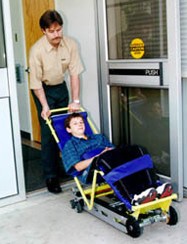Emergency Procedures
Disasters and major emergencies often occur without warning and create serious risk for the Napa Valley College community. The purpose of these web pages is to provide information on how the College plans to respond to a disaster or emergency, as well as information on how you should respond to emergencies you may encounter.
Although a number of specific emergency procedures are covered here, it would be impossible to list everything that could possibly go wrong.
When confronted with an emergency, remember these general guidelines:
- Remain as calm as possible.
- If you are instructed to evacuate a building:
- Cooperate with emergency personnel.
- Move at least 100 feet away from the building or as far away as possible.
- Keep streets, fire lanes, hydrants, and walkways clear for emergency vehicles and personnel.
- DO NOT re-enter evacuated buildings until designated officials say it is safe to do so.
- If requested, assist emergency personnel.
- An emergency command post may be set up near the emergency site. Keep clear of the command post unless you have information to report.
- The college may not have immediate assistance for up to 72 hours
- You should keep emergency supplies in your car and office.
Emergency Procedures at Napa Valley College
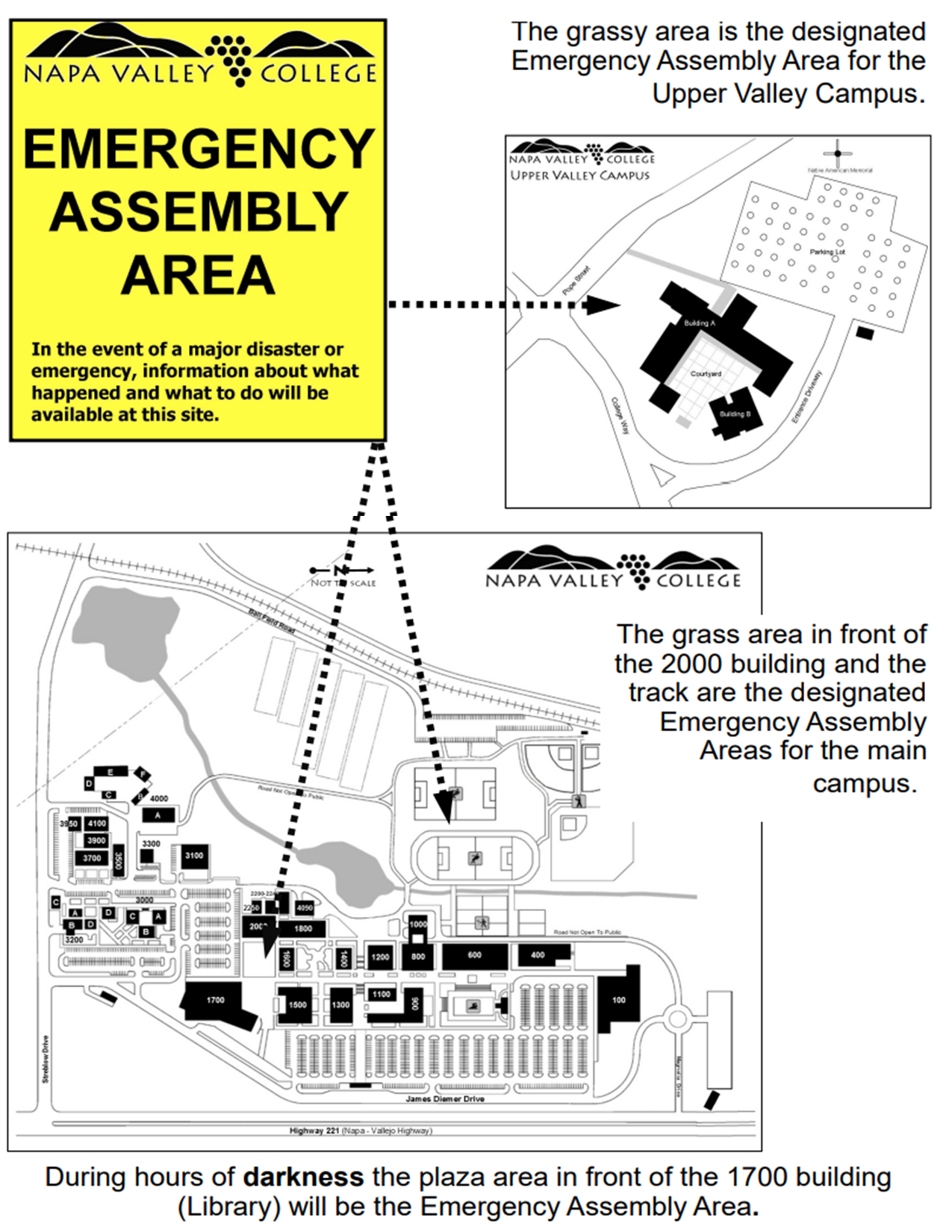
Create an Emergency Plan
- Meet with household members and discuss the dangers of fire, severe weather, earthquakes, and other emergencies.
- Discuss how to respond to each disaster that could occur.
- Discuss what to do about power outages and personal injuries.
- Draw a floor plan of your home. Mark two escape routes from each room.
- Learn how to turn off the water, gas, and electricity at main switches.
- Post emergency telephone numbers near telephones.
- Teach children how and when to call 911, police, and fire.
- Instruct household members to turn on the radio for emergency information.
- Pick one out-of-state and one local friend or relative for family members to call if separated by disaster (it is often easier to call out-of-state than within the affected area).
- Teach children how to make long distance telephone calls.
- Pick two meeting places, one near your home in case of a fire, one outside your neighborhood in case you cannot return home after a disaster.
- Keep family records in a water-and fireproof container.
Prepare a Disaster Supply Kit
Gather supplies you might need in an emergency. Store them in an easy-to-carry container, such as a backpack or duffel bag. Include:
- A supply of water (one gallon per person per day). Store water in sealed, unbreakable containers. Identify the storage date and replace every six months.
- A supply of non-perishable packaged or canned food and a non-electric can opener.
- A change of clothing, rain gear, and sturdy shoes.
- Blankets or sleeping bags.
- A first aid kit and prescription medications.
- An extra pair of glasses.
- A battery-powered radio, flashlight, and plenty of extra batteries.
- Credit cards and cash.
- An extra set of car keys.
- A list of family physicians.
- A list of important family information; the style and serial number of medical devices, such as pacemakers.
- Special items for infants, elderly, or disabled family members.
For more preparedness information go to www.ready.gov
The Emergency Operations Plan (EOP) is the college’s plan for handling major emergencies and disasters. This plan is based on a realistic approach to the problems likely to be encountered and is based upon the following assumptions:
- A major emergency or disaster may occur at any time of the day or night, weekends or holidays, with little or no warning.
- Since events in a major emergency or disaster are not predictable, published emergency plans will serve only as a guide and may require modification in order to meet the requirements of the emergency.
- Major emergencies or disasters may affect widespread areas; therefore, city, county, and federal emergency services may not be available. The college may expect a delay of up to 72 hours in receiving off-campus emergency help.
The goals of the plan are to protect lives and property and to restore instruction as soon as possible after a major emergency or disaster.
In the event of a disaster or major campus-wide emergency requiring a coordinated District wide response, an Emergency Operations Center (EOC) will be established in the Administration Building. The Emergency Operations Plan (EOP) will be responsible for directing the response to and recovery from an emergency or disaster.
In the event of a disaster or major campus-wide emergency, Incident Command Posts may be established near a specific incident to control the response. Incident Command Posts may also be established at the Upper Valley Campus or other District property as necessary. All Incident Command Posts report the District’s Emergency Operations Center (EOC).
During an emergency only authorized persons should speak to the media on behalf of the College. If you are approached by a media person, refer them to the College Police or Public Information Officer (PIO)
Do not offer opinion or speculation to the media.
Immediately after a major emergency or disaster (such as an earthquake), there is often a great deal of confusion and anxiety. You should remain as calm as possible and remember the following:
The college is committed to providing official emergency information as quickly as possible and will use the following emergency communications methods:
- Face to Face – Area Coordinators
- Face to Face – Police Officers
- Emergency Text Messages (SMS)
- Official Emails
- Phone Messages
- College Website
- Loudspeakers
- Audible Alarms
- Local Media
- Flyers and Display Boards
In the first few minutes after an emergency, official information will likely not be available.
The information you receive will be very brief and may not have all the details you
would like ...
Do not let that keep you from acting.
You may also receive emergency information via word of mouth or other text messages from students and staff. Even though it is not official information, if you believe you are in danger then take action ... Do not wait for verification.
The phone system, if it is working, may be overwhelmed and should only be used for emergency calls.
In an disaster emergency, information about what has happened, what to do, and where to go will be available at the emergency assembly areas as quickly as possible.
An effective way of providing emergency information to a large number of people is through the use of phone trees. The College encourages each department, division, or area on campus to develop a phone tree to communicate emergency information to the staff of that area. In an emergency supervisors will be notified by phone about the status of the college and what you should do. Supervisors should then use the phone tree to notify their staff.
ACTIVATION
The President (or designee) may activate emergency phone trees, whenever emergency information needs to be communicated to the college community.
Creating A Phone Tree
A phone tree can be created by using the provided 3x5 card template or by creating your own form. In either case start by:
- Dividing the department, division, or area into groups no larger than ten, with one person designated as the primary caller for that group.
- From within the group designate a back-up caller, who is responsible for making the calls if the primary caller cannot.
- The supervisor for the area should have a phone tree which consists only of the primary and back-up callers.
The supervisor in the area starts by calling the primary callers (the back-up callers would be called if the primary is not available) and gives them the information which needs to be passed on. The primary caller then calls all the people on their list passing on the information. This process is followed each time new information needs to be passed on.
For a phone tree to be effective the primary caller should call no more than ten people. Phone trees greater than one to ten often result in an information bottle-neck and defeat the purpose of a phone tree, which is the quick dissemination of emergency information.

In a major disaster it is possible for the college to be without immediate outside assistance for up to 72 hours. Everyone at the College needs to prepare.
For Faculty
The instructor, as the authoritative figure in the classroom, can influence how students respond in an emergency. Calm, collected and clear directions by the instructors will have a calming effect. In order for an instructor to exhibit this controlled demeanor, they should mentally rehearse how to respond if an emergency occurs during classroom instruction. For example, in a major earthquake, they should instruct students to duck, cover, and hold on until the shaking stops and then direct students to the emergency assembly area.
For Employees
All college employees should react as calmly as possible and follow the directions of their department head or emergency plan. The response to and successful recovery from a disaster will depend on thoughtful and cooperative response by all campus personnel.
For Students
Every student should become familiar with the information on the Emergency Information Posters, which are located throughout campus. In an emergency, you should react as calmly as possible and follow the directions of your instructor or emergency personnel.
For Department Heads
Be prepared to coordinate a local emergency response in your area until other help arrives. Develop emergency plans for your Department or area that include:
- Emergency checklists about shutting down and evacuating your area
- An up-to-date emergency phone tree
- Identified evacuation routes and where to meet at the emergency assembly area
- Encourage employees to have a personal emergency kit on hand. Information about individual preparedness (Information can be found at www.ready.gov)
California Government Code Sections 3100-3109 states in part, all public employees are considered Disaster Service Workers (DSW) when employed by any county, city, state agency or public district. The College is a public district.
What is my responsibility as a DSW?
In a disaster, you are required to assist in the response to and recovery from a disaster.
All employees of the District should view the DSW video at www.nvcpd.org, read the
general overview of what it means to be a DSW and how to prepare for an emergency.
What duties might I be asked to perform as a DSW?
In most cases, you will be given a general assignment based on the needs of the College
and your abilities. Examples of general job category duties you may be asked to perform
include: clerical support, damage assessment, driver, food preparation, interpreter,
etc.
What do I do if there has been a major emergency or disaster?
If you are at work
- Assist your class if you are teaching and then report to your supervisor.
- If you are in an office, execute your area response plan then report to your supervisor.
If you are at home or otherwise away from work:
- Take care of your family and personal needs
- Do not report to the College until contacted by your supervisor.
Listen to the radio to receive possible reporting instructions:
| Bay Area Radio Stations | North Bay Radio Stations | |
| San Francisco - KNBR (680AM) | Napa - KVON (1440AM) | |
| San Francisco - KCBS (740AM) | Vacaville - KUIC (95.3FM) | |
| San Francisco - KGO (810AM) | ||
The College Police can be contacted from campus phones in three ways:
911 - EMERGENCY HELP
Dialing 911 will put you in contact with Napa County Central Dispatch, who will contact the College Police and other necessary help. You should call 911 when:
- You see a violent criminal act.
- You see someone being attacked.
- Someone stops breathing or has a heart attack.
(707) 256-7777 - Urgent Assistance
Dialing (707)256-7777 will put you in contact with the college dispatch center or the on-duty officer. You should call when:
- You see or encounter a person acting suspiciously.
- You are the victim of a theft or other non-violent crime.
- Someone is hurt … but does not require an ambulance.
(707) 256-7770 - Routine Assistance
It should be used for routine business. You should call when:
- You have a question about a parking citation or issue.
- You are looking for lost and found property.
If you are the victim of a violent crime, such as assault, robbery, theft, or sexual assault.
- PROTECT YOURSELF!
- DO NOT TAKE UNNECESSARY CHANCES!
- AVOID UNNECESSARY RISKS!
Once it is safe to do so call 911 as soon as possible and supply the following information:
- What happened? (nature of the incident)
- Who did it? (description of people involved)
- Where did it happen? (location of incident)
- What property was involved, if any?
An armed intruder is a person who is actively engaged in killing or attempting to kill people with a weapon. You should know that;
- Victims are selected at random.
- The event is unpredictable and evolves quickly.
- You may not get an "official" notice to take action.
- Knowing what to do can save lives.
RUN
- Have an escape route and plan in mind.
- Do not hesitate and leave your belongings behind.
- Evacuate regardless of whether others agree to follow
- Help others escape, if possible.
- Do not attempt to move the wounded.
- Prevent others from entering an area where the intruder may be.
- Call 911 when you are safe.
HIDE
- Keep the attacker away from you.
- Hide in an area out of the intruder's view.
- Use any College key to engage the classroom intruder lock.
- Lock door or block entry to your hiding place.
- Silence your cell phone (including vibrate mode) and remain quiet.
FIGHT
- You have a right to defend yourself.
- Attempt to incapacitate the intruder.
- Do not fight fair.
- Act with as much physical aggression as possible.
- Improvise weapons or throw items at the intruder.
- Commit to your actions. your life depends on it.
- Decide to survive
WHEN POLICE ARRIVE
- Remain calm and follow instructions.
- Drop items in your hands.
- Raise hands and spread fingers apart.
- Keep hands visible at all times.
- Avoid quick movements toward officers, such as holding on to them for safety.
- Avoid pointing, screaming or yelling.
- Do not ask questions when evacuating
WHAT HAPPENS WHEN POLICE ARRIVE...
- The first officers to arrive on scene will not stop to help the injured. Expect rescue teams to follow who will treat and remove the injured.
- Once you have reached a safe location, you likely will be held in that area by law enforcement until the situation is under control and all witnesses have been identified and questioned.
- Do not leave the area until law enforcement authorities have instructed you to do so.
If you witness a criminal act or notice a person acting suspiciously on campus, immediately call the College Police at (707) 256-7777. Supply the following information:
- What they are doing?
- What do they look like?
- Where are they?
All College Police officers are trained in crisis intervention and are the designated first responders for campus crisis intervention and should be called whenever a disruption or crisis occurs.
When dealing with a person who is actively having a crisis:
- Avoid invading their personal space (within arm’s reach) or touching the person
- Always protect yourself.
- Get assistance by calling or having someone call 256-7777.
- Do not raise your voice; use a calm and clear voice.
- Do not get "hooked" into defending your credibility or allowing your "buttons" to be pushed.
- Do not threaten or ridicule the person.
- Do not get into an argument with the person.
When dealing with a person who is in distress:
Recognize Symptoms
- Significant changes in academic performance or classroom conduct
- Unusual or significant change in behavior or appearance
- Traumatic event or change in relationships
- Reference to suicide, homicide, or death
Respond to the Person
- Speak privately with the person
- Directly and candidly discuss your observations and concerns
Offer support and assistance
- Refer to a mental health professional
- Be caring, firm, and straight-forward in your referral
- consider calling from your office or escorting he person to the Student Health Center.
On Campus Resource
Student Health Center: (707) 256-7780
College Police: (707) 256-7777
CARE Team: (707) 256-7776
Most campus demonstrations will be peaceful. Attempt to carry on with business as normally as possible. Avoid provoking or obstructing demonstrators. No action is necessary unless one of the following conditions exists: Interference with the normal operations of the college
- Prevention of access to offices, buildings, or other facilities
- Threat of physical harm to persons or damage to facilities
If any of these conditions exist, the College Police should be notified at (707) 256-7777. The College Police will be responsible for contacting and informing the President.
Know the location of fire extinguishers, fire exits, and alarm systems in your area and know how to use them. If you discover a fire:
- Safeguard life and isolate the fire by closing all doors on your way out of the room. Do not lock the doors.
- Report fire or smoke by activating the nearest fire alarm.
- Call the Fire Department by dialing 911 from the nearest telephone or emergency phone.
- Slowly state, "I want to report a fire." Give your location (building, floor, room number).
- Do not attempt to fight a fire alone; report it immediately to 911. Firefighting should be delegated to trained firefighters, with the possible exception of a minor fire that could be quickly and easily extinguished by a portable fire extinguisher.
- Keep fire lanes and sidewalks clear for emergency personnel.
- Be aware of hazardous materials in your area and any special firefighting precautions that should be observed.
- When the building evacuation/fire alarm is sounded or when you are told to leave by the College Police or emergency personnel, walk quickly to the nearest marked exit and alert others to do the same.
- Assist disabled persons tin evacuating the building! Do not use elevators during a fire.
- Notify emergency personnel if you suspect someone may be trapped inside the building.
Smoke is the greatest danger in a fire. Stay near the floor where the air will be more breathable. If you are trapped in a building during a fire, if a window is available, open or break the window and place an article of clothing (shirt, coat, etc.) outside the window as a marker for emergency personnel.
Faculty and supervisors should inform students and staff of how to protect themselves before an earthquake. Information is available from the College Police, Ext. 7770.
DURING AN EARTHQUAKE
- If indoors, drop, take cover under a desk, table, etc. and hold on. Stay away from glass windows, shelves, and heavy equipment.
- If outdoors, move quickly away from buildings, utility poles, and other structures. Always avoid downed power or utility lines because they may be energized.
- If in an automobile, stop in the safest place available, preferably an open area away
from power lines and trees. Stop as quickly as safety permits but stay in the vehicle
for the shelter it offers.
After the initial shaking stops, evaluate the situation and if emergency help is necessary, call 911 or (707) 256-7777. Protect yourself at all times and be prepared for aftershocks.
If the building evacuation/fire alarm is sounding or if you are told to leave by the College Police, Area Coordinators or emergency personnel, walk quickly to the nearest marked exit and alert others to do the same.
Once outside, move to a clear area at least 100 feet away from the building. Keep streets and walkways clear for emergency vehicles and personnel. Listen for instructions from the College Police. If it is necessary, you will be instructed to go to an emergency assembly area where you will receive further information about local conditions and exit routes from campus.
Be alert for hazards such as building damage, gas leaks, fires, broken utility lines, spilled chemicals, and other potentially harmful materials.
In the event of an earthquake:
- Do not return to an evacuated building unless directed to do so by the College Police or emergency personnel.
- Do not use the telephone, except for emergency calls.
- Do not use matches or other open flames until you are certain there are no dangerous fumes present.
- Do not operate electrical equipment if gas leaks are suspected.
- Do not touch downed power lines.
Bomb threats usually occur by telephone. If you receive a bomb threat, remain calm and attempt to obtain as much information as possible from the caller by using the bomb threat checklist.
View a pdf version of the checklist.
If you cannot use the checklist, immediately write down the following information after the call:
- Time of call
- Age and gender of caller
- Speech pattern, accent, or other traits
- Emotional state
- Background noise
If you receive a bomb threat over the phone, immediately call the College Police at (707) 256-7777.
If you observe or find a suspicious object or potential bomb:
- Do not handle or move the object!
- Do not use cordless or cellular phones near the object.
- Do not turn any electrical switch on or off, this includes computers and copiers.
- Leave the area immediately and from a safe place call the College Police at (707) 256-7777.
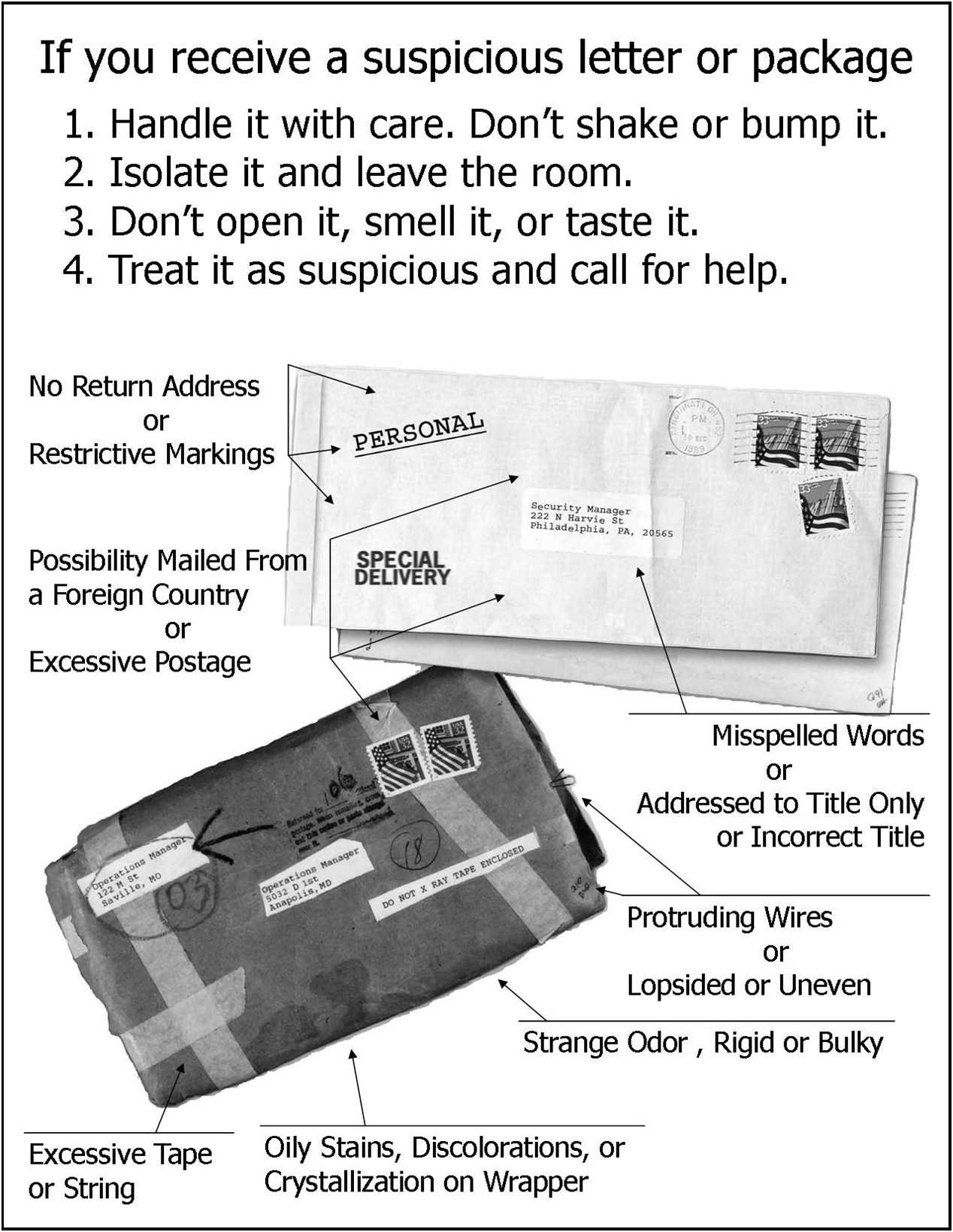
In the case of an explosion or similar incident on campus, take the following actions:
- Immediately, drop, cover under a desk, table, etc. and hold on. Stay away from glass windows, shelves, and heavy equipment.
- After the effects of the explosion have subsided, call 911. Give your name and describe the location and nature of the emergency.
- If necessary, activate a fire alarm.
- Evacuate the building
- Listen for instructions from the College Police or emergency personnel
- An incident command post may be set up near the emergency site. Keep clear of the command post unless you have important information to report.
- DO NOT return to an evacuated building unless directed to do so by the College Police, emergency personnel or an Area Coordinator.
Most acts of workplace violence do not occur in a vacuum or without warning; there are generally warning signs that precede the event. The risk of workplace violence can be minimized by careful observation and documentation of an individual's behavior, such as:· Boundary Crossing which includes pushing the limits of acceptable workplace behavior and continual testing established rules
- Chemical Dependence upon alcohol and/or drugs, which may create paranoia and aggressive behavior
- History of Violence which is the best predictor of violent behavior
- Inconsistent Work Patterns and Attendance Problems including periods of very high and very low work productivity, as well as unexplained or improbable excuses for absences
- Pathological Blaming by people who cannot take responsibility for their own actions, will not admit wrongdoing, and always blame others, the college, or the system
- Unusual / Changed Behavior including verbal outbursts, inappropriate remarks, and threats such as, "they'll regret this."
Workplace violence situations are often very complex, and you are not expected to handle the situation without assistance. If you think a workplace violence situation is developing, call the College Police at Ext. 7777 or Human Resources at Ext. 7100.
Most acts of violence do not occur in a vacuum or without warning; there are generally warning signs that precede the event. Those warning signs are often called "Behaviors of Concern," which are not a single behavior, but rather series of behaviors that when taken together and in context, may indicate the potential for a person to engage in violence or self-harm.
The risk of violence can be minimized by recognizing and seeking help when you observe the behavior of concerns, such as:
- Academic Indicators might be deterioration is quality/quantity of work, extreme disorganization or erratic performance. Disproportional response to grades of other evaluations
- Boundary Crossing which includes pushing the limits of acceptable classroom/ workplace behavior and continual testing established rules
- Chemical Dependence on alcohol and drugs, which may create paranoia and aggressive behavior
- Violence in the form of written or artistic expressions of extreme violence. Statements about current or past acts of violent behavior
- Changes in Patterns and Attendance Problems including periods of very high and very low work productivity, as well as unexplained or Improbable excuses for absences
- Pathological Blaming by people who cannot take responsibility for their actions, will not admit wrongdoing, and always blame others, the college, or the system
- Unusual / Changed Behavior including verbal outbursts, inappropriate remarks, and threats such as, "they'll regret this."
- Suicidal behavior or talking about ending their life.
The dynamics of potentially violent situations are complex, and you are not expected to handle the situation without assistance. The College Police or the CARE Team are available to help.
College Police (707) 256-7777
CARE Team (707) 256-7776
Call the College Police immediately at 256-7777 to report the spill, leak or release.
- When reporting, be specific about the nature of the material involved and the location. The College Police will contact the necessary specialized authorities and medical personnel.
- The instructor or supervisor should evacuate the area at once and seal it off to prevent further contamination until emergency personnel arrive.
- Anyone who may have been contaminated should stop and remain in the vicinity. Make sure that each person's name and location is given to a College Police or emergency responder.
DO NOT activate the fire alarm unless there is a fire.
DO NOT return to an evacuated building unless directed to do so by the College Police, emergency personnel or an Area Coordinator.
Try to stay calm and attempt to slow things down. Be alert to situations that you can utilize to your advantage, such as getting the abductor to see you as a person, not a thing. Remember that the primary objective of the college, College Police, and police officials will be to secure your safe release as quickly as possible. Do not discuss what action your family, friends, or employer may take.
Generally, do not expect a good opportunity for escape. Attempts to escape should not be made unless you think your life is in imminent danger.
Avoid making provocative remarks to your abductor. They may be an unstable individual who could react explosively and are likely to become violent and abusive. Try to establish some kind of rapport with your captor.
If you see someone taken hostage, immediately call 911.
PLUMBING FAILURE/FLOODING
Cease using all electrical equipment.
Notify Facilities at Ext. 7580, or the College Police at Ext.7777.
GAS LEAK
Cease all operations.
Do not switch lights on or off.
Evacuate the area.
Call the College Police at 7777.
VENTILATION PROBLEM
If necessary, cease all operations and evacuate the area.
Notify Facilities at Ext. 7580, or the College Police at 7777.
ELEVATOR FAILURE
If you are trapped in the elevator, use the emergency phone to call for help.
Turn on the emergency alarm located on the front panel, which will signal for help.
If a power outage occurs during daylight, the college will remain open. The phone and emergency system will continue to operate, and most rooms on campus will have enough ambient light to continue activities.
Some classrooms and areas of the campus may be closed because they will be too dark or las areas that require special equipment.
The decision to continue a class or keep an office open will depend on whether you have enough light in your area. If you are teaching in a room with no light, contact Instruction at 707-256-7150 for direction. If you are going to close your office, you need to get approval from your supervisor.
If a blackout or power outage occurs after dark, classes may be excused after 15 minutes. When the lights go out, please remain calm, use whatever light sources you have, and wait in your room or area. Wait for 15 minutes. If the lights have not come back on, you should have your students or staff make their way to their cars and leave the campus.
Please remind people to:
- Walk to their cars in groups and use caution.
- Look out for other people walking to their cars when driving out of the parking lots.
- Treat any intersection without working signal lights as a 4-way stop.
Some classrooms and offices are equipped with an Emergency Light Stick box, which contains two light sticks, which can be removed and used as a light source.
In the event of a medical emergency on the main campus:
- Life Threatening (Not Breathing, Unconsciousness, Heart Stops) ~ Call 911
- Urgent (Bleeding, Shortness of Breath, Disorientation, Seizures) ~ Call 707-256-7777
- Non-Urgent (Illness or Minor Injuries) ~ Call 256-7780 ~ Student Health Center
When calling for help give your name, location, and callback number. Stay on the phone and give as much information as possible regarding the nature of the injury or illness, whether or not the perso is conscious, bleeding etc.
Do not move an injured person unless there is a life-theatening situation. Stay with the person until emergency help arrives and render first aid, if you are trained to do so. At the Upper Valley Campus if you encounter a medical emergency, call 911.
Injury/Illness Reporting Procedures
Employees of the District are required to report work related injury or illness to their supervisor. The supervisor should immediately report the injury to the Office of Risk Management and complete the Supervisor’s First Report of Injury. If the employee seeks medical care and/or misses more than 1 working day, they must complete a DWC-1(Workers’ Compensation claim) form. All the forms may be obtained from the Office of Risk Management at 256-7580
Shelter in Place
A building may be temporarily closed in response to a problem or security threat near a building. The purpose is to convert the building into a locked, secured and safe environment to shelter in until the problem is resolved.
- Close and, if possible, lock the classroom or office door.
- Leave your cell phone on, but put it on silent.
- Continue teaching or working and wait for official information on what to do.
- Students and staff in hallways should seek shelter in the gym and wait for official information.
Lockdown
A lockdown is immediate action taken in response to an active shooter incident. Such an incident can occur anytime, anywhere, to anyone, and it will be unlike anything you have ever experienced. Active shooter incidents happen very rapidly, which means you may or may not get an “official” lockdown warning. You need to take immediate action; do not wait for an official notice.
- Call Out – to 911. Don’t assume some-one else has done it. Tell 911 dispatcher where you are and what you saw.
- Hide Out – If you can’t get out, then find a place to hide. Lock the door if you can. Turn out lights and be silent. Put cell phones on vibrate. Don’t peek out – wait for the police.
- Keep Out – If the door can’t be locked, then block the door with whatever you can. If the door opens out, then use belts to tie the door to heavy objects.
- Spread Out – DO NOT huddle together. Remain calm and stay focused on survival.
- Take Out – If the shooter enters your area, assume their intentions are lethal. Fight or do whatever it takes to survive ... Your life depends on it.
Evacuation
In a disaster or major emergency, evacuation of a specific building may be necessary. Classes, departments, and offices in every building should agree in advance on an outdoor meeting place away from the building. A building evacuation will occur when a fire alarm sounds or upon notification by the College Police or emergency personnel.
- Be aware of all marked exits from your area and building. Know the routes from your work area.
- If necessary or if directed to do so by College Police or emergency personnel, activate the building fire alarm.
- CAUTION: Building fire alarms may stop ringing; even if they stop, continue the evacuation.
- When the evacuation/fire alarm sounds or when told to leave by the College Police or emergency personnel, walk quickly to the nearest marked exit and ask others to do the same. DO NOT use elevators unless directed.
- Once outside, move to a clear area that is at least 100 feet away from the affected building. Keep streets and walkways clear for emergency vehicles and personnel.
- If requested, assist emergency personnel.
- An emergency command post may be set up near the emergency site. Keep clear of the command post unless you have important information to report.
- DO NOT return to an evacuated building unless directed to do so by College Police or emergency personnel.
If an extended evacuation is necessary, you should go to the college’s emergency assembly areas, where information and assistance will be provided.
In the event of extended nighttime evacuation you should assemble at the college’s flagpoles.
FAQs
Q – Will a college official come to my classroom or office?
A – Maybe, but you should not wait for verification to act.
Q – A person wants to leave the room that we have secured ... What should I do?
A – Tell them that it is not a good idea. If they insist, then let them go.
Q – We have secured our door and people are knocking on it; should I let them in?
A – NO... do not let anyone in after you lock or barricade your door. Tell then to
go to the gym.
Q – How will I know the situation is resolved?
A – Wait until you get an “All-Clear” message from either an official (Area Coordinator
or Police Officer) or through one of the information sources or methods listed in
the "information" above.
Q – What should I do during a shelter-in-place incident?
A – You should continue teaching, working, or studying but stay where you are, and
out of the hallways. Wait for official information on what to do.
If buildings are damaged in an earthquake or other emergency, they will be inspected as soon as possible and posted with a red “CLOSED” or green “OPEN” sign.DO NOT re-enter a building that does not display a status sign.
The following guidelines should be considered in evacuating persons with disabilities:
- FIRST, communicate the nature of the emergency to the person.
- SECOND, ask the person how you can assist.
- THIRD, if possible evacuate mobility aids and assistive devices with the person (i.e. crutches, wheelchairs, etc.).
Visual Impairments
Describe the nature of the emergency and offer to guide the person to the nearest emergency exit. Have the person take your elbow and escort them, while advising of any obstacles, such as stairs, narrow passageways, or overhanging objects. When you have reached safety, orientate the person to where you are and ask if further assistance is needed.
Hearing Impairments
Most buildings are not equipped with flashing light alarms, and persons with impaired hearing may not perceive that an emergency exists. Communicate with the person by writing a note or using simple hand gestures. Allow the person to see your face when speaking, in case they can read lips.
Persons Using Wheelchairs
Ask the person what method of assistance they prefer. Some people have minimal ability to move, and lifting them may cause injuries to them. Some persons using wheelchairs have respiratory complications; remove them from smoke or fumes immediately. If the disabled person wants to be moved in his or her wheelchair, keep the following considerations in mind:
With Their Wheelchair
- Ask if they want to move forward or backward over curbs.
- Wheelchairs have many movable or weak parts.
- Some persons have no upper trunk or neck strength.
- Power wheelchairs have very heavy batteries; an evacuation chair may be needed and the chair retrieved later.
- If a seatbelt is available, use it!
- DO NOT attempt to move a person in a wheelchair by yourself; seek help.
Without Their Wheelchair
- Use the evacuation chair as described on the pages 21-22 of this guide.
- Ask if they can move their extremities or do they need help.
- Ask if the seat cushion or pad is necessary.
- If possible move the wheelchair with them, but NOT with them in it.
- Ask what is necessary for after-care
In many of the multi-story buildings you will find an evacuation chair in a cabinet near the evacuation assembly area for persons with disabilities. The chairs are designed to be operated by one person. To operate the chair:
Step One
- Remove the Evacu-Trac from the storage cabinet and place the unit on a flat surface.
- Grasp the handle and pull it up in a quick, smooth motion.
- This will lock the Evacu-Trac in the open position.
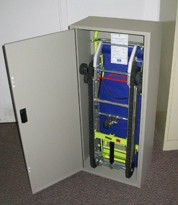
Step Two
- The Evacu-Trac brake is normally on. To descend the stairs, release the brake by slowly squeezing the brake lever.
- Descent speed can be slowed by reducing pressure on this lever.
- A governor limits the maximum descent speed to about three feet per second, allowing even a small attendant to safely transport heavier riders.
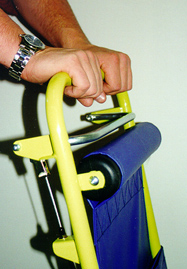
Step Three
- Transfer passenger from their wheelchair to the Evacu-Trac.
- Three Velcro straps are provided for securing the passenger.
- These straps help immobilize an injured person or help transport a person with no upper body control.
- The lower torso straps allows a younger passenger to be well secured while being transported in the Evacu-Trac.
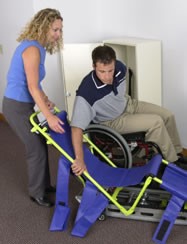
Step Four
- On stairs, the tracks securely grip the stair noses and control the descent speed regardless of the stair covering.
- On flat surfaces, Evacu-Trac can be pushed on its wheels as easily as a stroller.
- This features allows the user to be transported to an area clear of the emergency rather than to an area of refuge.
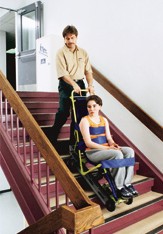
Step Five
- It is recommended to use the inside of the stairway to allow room for other traffic and to make it easier to turn corners at stairway landings.
- To turn the Evacu-Trac on flat surfaces, the attendant pushes down on the handle and pivots the unit on the rear auxiliary wheels.
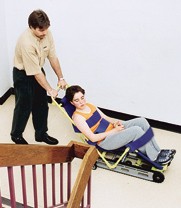
Step Six
- Once clear of the emergency area, park the Evacu-Trac on a flat surface and engage the brake by releasing the bar.
- Transfer the person back to their wheelchair.
